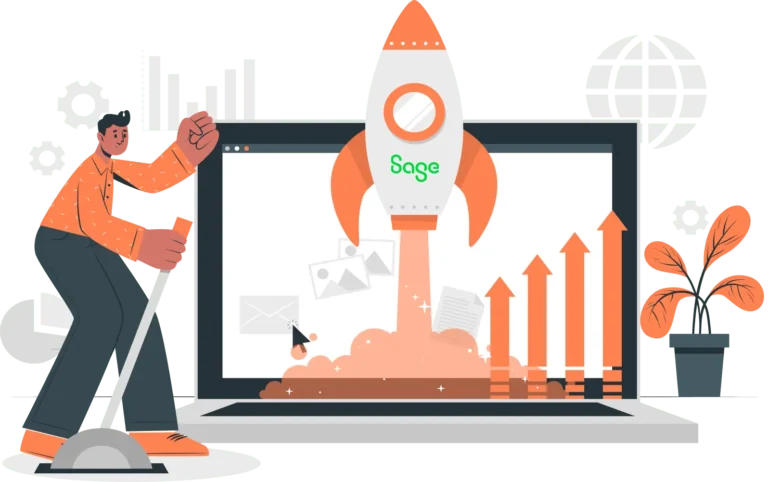
March 26, 2025
Effective budgeting and financial forecasting are crucial for any business. They allow business leaders to plan for current and future needs and position the company for faster growth. Managing budgets and creating financial forecasts can be challenging, particularly if accounting staff are still performing manual calculations or are overly dependent on outdated systems.
That’s where Sage ERP comes in. Sage accounting and ERP software includes powerful accounting and financial forecasting tools that help businesses manage their budgets, analyze financial trends, and make better, faster decisions based on real-time financial and operational data.
Getting the most benefit out of your budgeting and forecasting activities in Sage requires understanding how to best configure and run reports. In this guide, we’ll explore how you can leverage Sage for budgeting and forecasting to optimize your financial management.
Why Use Sage for Budgeting and Forecasting?
Sage streamlines the budgeting and forecasting process and offers multiple benefits for companies.
It increases automation, which reduces manual data entry and data errors. Sage also provides real-time visibility into financial and operational data, which allows you to get up-to-date insights into your business. Customizable reports and dashboards make it easy to visualize data and spot trends.
Sage makes it easy to create detailed budgets tailored to suit your business needs, including real-time tracking and benchmarking so you can always see where you stand relative to your budgeting goals. It allows you to model different financial scenarios so that you’re prepared for anything the market throws at you.
Setting Up a Budget in Sage
Follow the steps outline below to set up a budget in Sage.
1. Navigate to the Sage budgeting module. This can typically be found under the financial or planning sections.
2. In the Sage budgeting module, define your budget categories. This involves identifying and inputting key expense and revenue categories that are relevant to your business.
3. Input historical data. Upload or manually input your historical data. Sage will use your past financial performance and data to inform budge estimates.
4. Set budget limits. Allocate funds to different departments, projects, or cost centers. This will allow you to control and monitor your budget for different areas of your business.
5. Review and adjust your budget to align with company objectives. Periodically go in and adjust your budget as necessary, including comparing your projected budgets with your company’s financial performance and spending.
Using Sage for Financial Forecasting
Financial forecasting helps businesses prepare for the future by anticipating future cash flow, revenue, and expenses under different financial scenarios.
Here is how to best configure and use Sage’s forecasting tools.
1. Analyze historical data. First, you should start by analyzing your past historical data. Sage provides easy tools, including dashboards, reports, and artificial intelligence (AI) to provide insights into your historical data.
2. Use Sage’s forecasting tools to predict future trends. Once again, Sage’s reports, dashboards, AI, Business Intelligence (BI), and Machine Learning (ML) tools help you better visualize and analyze data, including modelling likely future financial performance.
3. Create multiple financial models. Use Sage’s scenario analysis tools to create multiple different future scenarios to help you understand the potential impacts and risks of making different business decisions.
4. Automate forecasting reports. Set up scheduled reports to track projections against actual results. This will allow you to quickly make adjustments as economic conditions or the financial health of your business changes.
5. Refine and optimize your projections. Ideally, your financial projections should be living, breathing calculations that grow and change alone with your business. You should continually update and revisit your projections based on real-time business performance and market conditions.
Best Practices for Budgeting and Forecasting in Sage
Now that we’ve gone through how to configure budgeting and forecasting in Sage, let’s examine what are best practices for budgeting and forecasting. Adhering to these guidelines and best practices ensures that you get the best possible budgets and financial forecast while using Sage.
1. Regularly update your data. Any system is only as good as the data input into it. While Sage should automatically collect and record financial and operational data from across your business, some data still may have to be input manually, particularly if you don’t have third-party integrations to systems like your eCommerce site. You should periodically ensure that financial data is being correctly input into Sage and that it is current for accurate forecasting.
2. Use Sage Analytics. Take advantage of Sage’s reporting tools to generate deeper financial insights.
3. Involve Key Stakeholders. Keep key stakeholders, including directors and department heads, involved in the budgeting and forecasting process.
4. Monitor Variances. Even the best financial forecasts and models don’t always match with reality. It’s important to compare your actual financial performance with your financial forecasts and adjust them accordingly.
5. Leverage Sage’s AI and Automation Tools. Use Sage’s AI-driven features to enhance your predictive analytics and improve financial forecasting.
Budgeting and Forecasting in Sage
Sage is a great choice if you’re looking to improve your budgeting and financial forecasting processes. Leveraging its automation, real-time reporting, and analytical capabilities will allow you to make better, faster decisions that drive faster business growth and better stability.
At CertiPro, we’re experts in all things related to Sage and Sage eCommerce integrations. We’ll help you configure and install your Sage system, including setting up any customizations that you need. Contact us today to see what we can do for your business.

